|
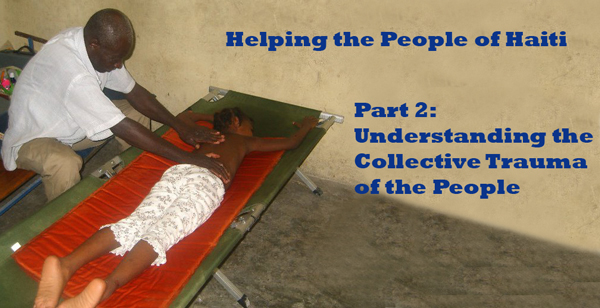
Editor's note:
This is Part 2 of a report written by Julia Graves and Thupten Jinpa after they returned from a second trip to Haiti in 2010 where they organized a community health clinic. An extended group of
practitioners
accompanied them and offered homeopathic, herbal, flower essence, aromatherapy and related treatments to all those who came to the clinic. Flower essences played a central role in helping with the emotional trauma still prevalent among the people served.
Part 1
features some of the major flower essences that were used in the healing work. Part 2 gives a deeper insight into the healing work and the collective needs in Haiti. This report has been edited for presentation. Photographs are courtesy of Sandra Lory. Read the report about the first clinic
here
.
Returning to help greater numbers of people
Addressing the devastating conditions of homelessness
Helping mothers and their babies
Flower essences help the ongoing emotional trauma
Helping return patients continue their healing
Great gratitude on the part of those treated at the clinic
Empowering people to take responsibility for their own health
Treatments continue as people recognize the value of the local healers
Finding new footing: healing collective trauma
Returning to help greater numbers of people
On our second trip, we (five women herbalists and one man) found Haiti somewhat cleaned up with the worst of the rubble having been removed from the streets and some business having started up again; but the general situation is still far from what it was before the earthquake. Our host Bernard told us, “While it looks like things are back to normal on the surface, if you don't really look, underneath nothing is back to normal.” What is back to normal are big banks and international corporations, but little else. Foreign aid money has not been received, since the foreign governments smartly insist to control themselves how to distribute the money in a corruption-ridden country, while the Haitian government selfishly insists that those huge sums must be given to, and distributed by, the Haitian government itself (so they can disappear in the private pockets of whoever handles the money). The biggest and nicest advertisement billboards advertise the national police as a courteous and reliable force in the country - the mere fact that that has to be advertised tells you it is far from the truth. We found a heart broken, devastated, displaced and demoralized people inflicted by poverty, starvation, epidemic disease, unemployment and homelessness. It is difficult to not feel happy about whatever little help you can offer in such a situation, even knowing that what you have to offer falls so short of what is really needed.

Addressing the devastating conditions of homelessness
We were offering a mobile naturopathic clinic that set up shop in the poorest, most devastated areas in and around Port-au-Prince and Leogane, a small town almost entirely flattened by the earthquake. This time, we faced a bad wave of flu, yellow fever, malaria, diarrhea from dirty food and water, and a vastly damaging tornado. In Leogane, where practically the entire town collapsed, we met a host of amputees and people with trauma from having been trapped in or under the rubble of their houses. Almost everyone still lives in tents or under tarps, and in the tent cities set up for those whose houses collapsed, the walls of one tent touches that of the other, while inside people sleep crowded like sardines. Most tent “cities” have inadequate sewage systems, if any at all, and no potable water—a situation rife for what we found: every kind of imaginable skin and eye infection, diarrhea, coughs, colds, flu, and any other kind of epidemic disease, plus diseases such as tertiary and congenital syphilis. Returning to the same tent city for a second time after March, we found that now, most children were severely malnourished—hundreds of children with reddish blond crispy hair that should be black—from the lack of food. In Carrefour Cote Plage, the area closest to the epicenter, almost everyone coming to the clinic had “severe stomach pain worst in the morning and before eating,” in children and adults so thin you can see the bones through their skin. It was devastating to know we had no medicine to offer against hunger pain. Considering offering meals, we realized that to hand out food in Haiti, one needs armed soldiers around to prevent a stampede, so we had to let go of that idea and instead offered the suggestion to drink a cup of the dirty water to allay the pain... (It feels horrible to eat lunch after working in a place like that.)
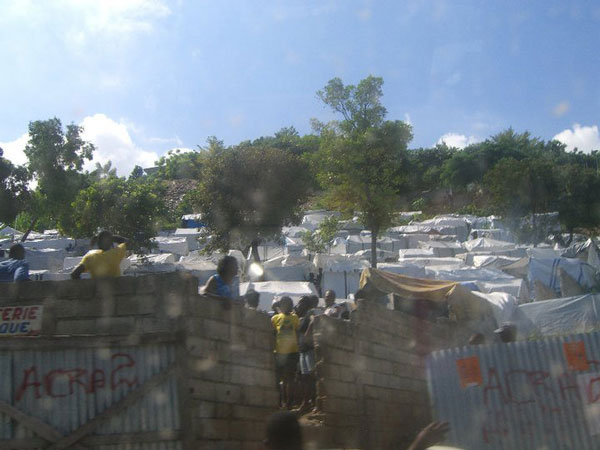
Helping mothers and their babies
Another side effect of the tent city ghettos, is that no one is working, and everyone is just hanging around apathetically waiting for the water truck, or rice and bean allotments to come: this is the kind of “no future” attitude of ghetto dwellers. While this is not true of the older people, the younger generation, especially the teenage mothers, seem to have lost any kind of incentive to change anything for the better in their lives. For instance, one of them sent her one month old baby who seemed to be on the verge of dying with yellow fever, over with another teenage friend. I asked for them to bring the baby back to check that the fever was down later in the afternoon, but she still was not the person to bring the baby. When I finally summoned her, she seemed indifferent to the fate of her child and unwilling to do anything herself for his well being, such as a sponge bath – too much trouble. Other young mothers with means to buy food would ask us for vitamins for their children, and when we explained that fruits and vegetables were the best source of vitamins, they would say, “But I don't have time to cook them.” Asked, “What do you do for work?” “Nothing, I'm jobless, it just takes so much time to chop them." So with the earthquake, not just buildings caved in, but it undermined an active, resourceful society.
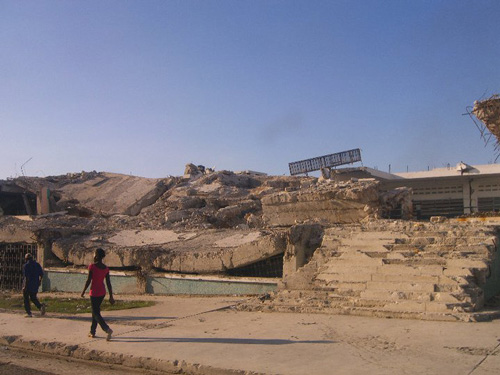
Flower essences help the ongoing emotional trauma
With a little less of an acute epidemic situation than in March, the general population is still shocked, depressed, and profoundly disturbed from the earthquake. Given that the earthquake hit in the daytime, most children were in school and died in the collapsing school buildings. In this way, the country lost an entire generation. I was surprised just how many times the key question in the intake interview, “Since when do you have those symptoms?” was immediately answered by “Since the earthquake.” Chronic headaches, breathing troubles, heart aches, pains, and disturbances, sleeplessness, stomach aches, dizziness and faintness were amongst the most common of post traumatic stress disorder symptoms, followed by a host of injuries from falling debris about which no one complains. The answers must be discerned by questioning. “I have pain in my chest when I breathe." “Since when?" “Since the earthquake." “What happened to you in the earthquake?” “Nothing.” “Did you get hit or did you fall?” “Yes, I got hit by debris in my ribs.” We were ever so grateful to have a qualified bone setter on the team for all of those cases of crushed feet, head traumas, displaced ribs, etc.
Another very physical aftermath of the earthquake is scores of people with “dust lungs,” with trouble breathing, and restricted feeling in the lungs since the earthquake. In 99% of the cases, when asked, these people would say that they breathed in a lot of dust when the buildings around them caved in. In any of those cases, the secret to the cure lay very much in the fanciness of the wrapping; the more “from a rich country” the packaging, the greater the enthusiasm was with which the remedy was received. This was clearly topped by the flower essence misting bottles donated by FES. There was, however, a clear generation gap—the old people, still very much used to herbal home remedies, were very receptive to brown paper bags with dried herbs as a promising cure, while the teenagers and young tweens seemed to be incredulous that we could consider anything other than industrially manufactured tablets.
People have still not healed from the earthquake. This is clear from the testimony of all of those children and adults who were buried under the rubble for days, all of whom are now suffering from nightmares, visions of the earth opening up and swallowing the dreamer, houses collapsing over them again, being chased by devils or bad spirits. People reported that they and their children were healed from the nightmares by the flower essences we gave them.
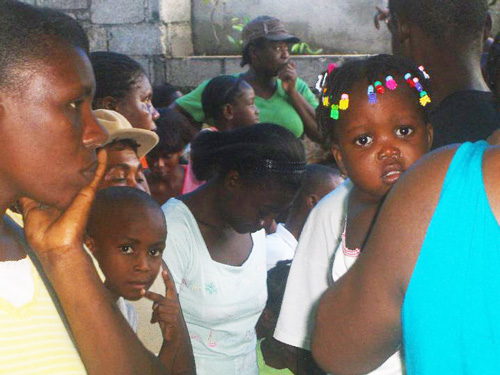
Helping return patients continue their healing
We heard that our first clinic had left quite a reputation behind, and that people would pass repeatedly in the places where we had been to ask when we would return. This time, people traveled as far as three hours to attend the clinic, because, “We have never in our lives seen skin rashes, joint pain and vaginal infections clear up over night.” Others would get on a taxi bus to go more than halfway across town for two hours one way to fetch family members to have them visit the clinic. This is not because other places do not offer medical care, but because they do not offer the kind of medical care we did. One lady traveled for two days (one day walking and one day by bus) because somebody else said something that motivated her to take the journey. A mother of nine children, she is depressed and suffers from menstrual abnormalities. We hope we were able to help her.
We were very pleased to have a good number of return patients, so we could monitor their further healing. This includes a little boy who had gotten hit by a piece of rock in the head so hard that he could no longer see, open his mouth to eat or speak, and who wanted to die. We found him bouncy, happy and well, still complaining of vision trouble and memory lapses, which is so common after a heavy head trauma. Back in school now, we again provided him with a series of treatments which included setting the bones of his head and neck, and giving him homeopathics. It was heartbreaking to see how many children came to sit in front of us saying, “Please give me medicine for my memory, I cannot follow in school any more.” “Were you hit in the head during the earthquake?” “Yes, a cinder block fell on my head.”
Head traumas are so devastating, and this is certainly true for the little mentally handicapped girl who had fallen head first out of a third floor in the earthquake. She seemed limp and drugged when she came in, and was entirely changed after the bones in her head and neck were set—suddenly alive, she was making eye contact and started to interact.
Many people returned to the clinic, asking for a refill, “What you gave me last time worked like a miracle—please give me more!” Jinpa observed: “I had many clients return—a lot of them had come with diarrhea, skin infections, fever, headache, or whatever. All of them where cured, but they returned in some cases a few weeks after the remedies were used up. So, they were back to ask me for more. But, none of the shock symptoms returned, such as heart palpitations, insomnia and fear. This is due to the power of the flower essences we have been giving.”
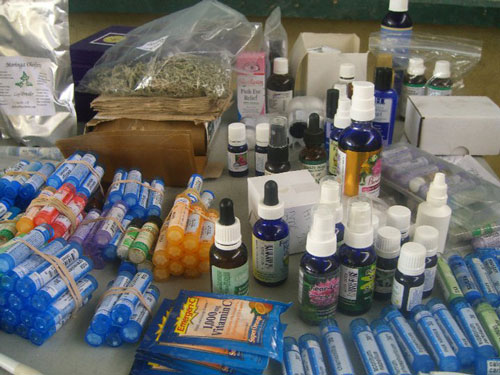
Great gratitude on the part of those treated at the clinic
As last time, we were literally overrun by suffering crowds and would sometimes have to stop people from fist fighting over their places in line. Handing out numbers greatly helped, but then suffering makes one impatient to spend hours waiting. While we heard from other medical relief workers that they felt that the Haitians had not been grateful for what they did, we were regularly showered with praise – and one day in one of the worst areas, a father of five, who had just been seen with all of his children wrote this note and asked the crowd to hand it to me:
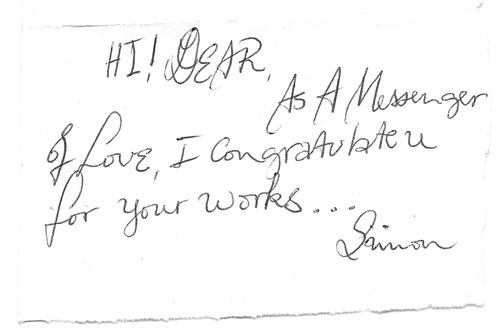
Praise for our work was far and wide, yet that did not translate into the crowd not shoving and screaming. People would leave the clinic and bring back relatives from hours away for the next time because they were so satisfied with the results. We are grateful for this, since we did not have more than 5 to 10 minutes on average to spend per person, so it seems that our “tried and true recipes” really worked.
A lot of people commented that they preferred our cures over what they were given at the hospital “because there are no side effects!” One woman came to Jinpa's father asking “Is that black magic they use in their medicines?" He responded “No, it's healing plants.” “I put the ointment on my baby's skin rash and went away to cook. When I finished and came back, the rash was already gone—as if by magic!” “Well, that's the power of natural healing."
Empowering people to take responsibility for their own health
Despite the overwhelmingly positive response to the last clinic, we felt that one thing demanded improving: many patients at the time asked, distraught, “Now that you are leaving, where will we get a refill of this medicine that works so well?” We realized that in a sense, we were creating another model of dependency on foreign help. This time we offered educational classes for those who waited in line, including talks on which plants to use for common colds, how to boil guava leaves for diarrhea, and how to inhale smoke of dried eucalyptus leaves to cure a cold. Since we had had very good success with essential oils, we made a point of using locally made Vetivier essential oil as much as we could, so people could buy that locally if they can afford it.
Treatments continue as people recognize the value of the local healers
Jinpa observed, “We learned that our employing the local herbalist, midwife and bonesetter reminded many people of their local alternative. ‘Oh, I forgot – I also have a bonesetter in my neighborhood – maybe I should go see him!’ We are thus trying to increase Oliama's visiblity and prestige to allow the Haitian people to reconnect with their own naturopathic tradition. As a result of the first clinic, Oliama has received a constant small number of clients who have some kind of livelihood, and who give a 50% co-payment for the treatment.”
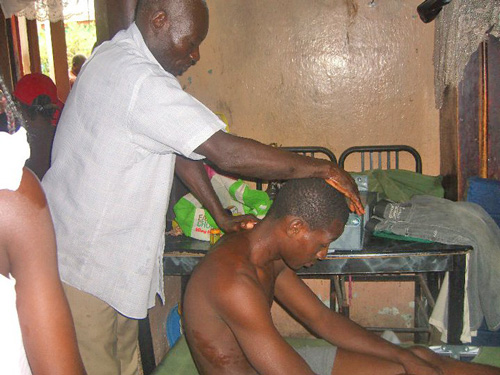
While we were gone, Oliama saw an ongoing stream of these clients returning for follow-up treatments, as well as new people who regained confidence in their own local healing system. While the poor received free treatment, those who could afford it paid half. In his poor neighborhood in Petionville, he also delivers babies for about 20 to 30 women per month and is the doctor for 50 children considered as orphans housed together at a shelter since the earthquake. He treats all of those people either as an herbalist, midwife, or bone setter, depending on what is needed. We are continuing to support his work with $300 US a month.
Alma's comment on our homeopathic injury treatments was, “I never ever experienced this before in my life that my adjustments hold up so well and for so long!" So our goal of synergistic co-treatment was thankfully fulfilled. Oliama also observed that it gave the clients better mobility.
Finding new footing: healing collective trauma
We were very happy that because of the fact that there was somewhat less acute epidemic disease, we had the luxury to treat more of the emotional trauma left in the wake of this devastating event. Once easy-going and smiley, most Haitians are now serious, and many children look depressed and have deep black rings under their eyes. The monstrosity of the trauma, and the chaos and problems it left in its wake, seems to inhibit people from grieving—how to get the next bit of food or other living essentials—is what is on the agenda, and not grieving and processing. Very few people will walk into the clinic and say, “I got emotionally traumatized in the earthquake, this is why I have my symptoms, please treat them.” We usually have to dig up that truth with repeated, meticulous questioning. “What happened to you in the earthquake?” “Nothing.” “Were you in a building that fell in?” “Yes.” “Did you get hit?” “No.” “Were you under the rubble?” “Yes, but only up to midnight.” This minimization of one's trauma in the face of the monstrosity of what happened is commonplace. And—“How can you not have gotten hit by the rubble if you where under it for half a day?” “Well, I did not get hit as bad as those who died.” Even adult men who did not get injured nor had any loss now report, “Since the earthquake, [which reportedly was so bad that the building was literally lying on the side and came back up like in a gigantic wave] I sometimes suddenly feel like I am losing footing, like my legs will give in and I will fall [like in the earthquake].” In people's souls, the big quake of January 12 is still omnipresent.
As most cultures, Haitians are unaware of early childhood trauma and assume that children who were not directly injured had nothing happen to them. In fact, all of these children seem profoundly disturbed by their entire universe spinning out of control so suddenly and violently. While their parents would often insist that nothing had happened to them and that they were fine, when asked directly, they admitted to being scared and disturbed. Our simple test was to give them a mix of flower essences for trauma, and in almost all cases, the child would immediately break into its first smile after receiving the dose. Well, we beg to differ about this “nothing happened to our children” attitude. The guardians at schools and orphanages still observe that all children appear depressed.
Using Fear-Less for in utero trauma
A new phenomenon we saw this time were the new born babies who were just conceived or in utero during the earthquake. While again, all mothers insist that nothing happened to the baby, they seem unhappy, depressed, lifeless, or disturbed. Surprisingly often, these infants have shaking or trembling limbs or their legs shake uncontrollably when they try to push themselves up. These infants in particular responded to the Fear-Less
spray by opening their eyes, becoming present, focusing their eyes, smiling—in other words, “being there” for a change. While intrauterine collective trauma, as I might call it, might not play out in precise nightmares or symptoms, it definitely makes for “absent” infants that seem disengaged from life. Many women in all stages of pregnancy at that time reported having fallen onto their bellies or being hit hard in the belly.
The pastor at a local orphanage we visited remarked, “By treating all of these children, you are treating a whole part of Haiti for a long time into the future!” This was one of our goals—helping the lives of those traumatized children, a whole generation of them, become “unstuck” so that they can move on into a bright future and rebuild a better Haiti.
This time, we also had brought medicinal and vegetable seeds, as well as Moringa tree seeds (thanks to the donation of Moringa Farms) to help people grow their own anti-malaria herbs and nutritionally valuable greens.
Client vignettes
I saw a little girl in the clinic who complained of chronic pain
in her foot. It transpired that it had been crushed by debris in the earthquake. I gave her some Arnica 200 C and sent her to be seen by Oliama. Marguy took her over, and on the way down the steps she said to Marguy, “Oh, my pain is already entirely gone! I don't have to go see the gentleman any more!”
An old gentleman who had been severely shocked by the earthquake
had subsequently lost his ability to make eye contact, speak or understand French, or even maintain a conversation much beyond one sentence in Creole. We had left him with a Post-Trauma Stabilizer formula, and were surprised to find him greeting us with a smile and in fluent French, maintaining long and complex conversations. He now clearly showed a hearing loss from the shock, for which we treated him.
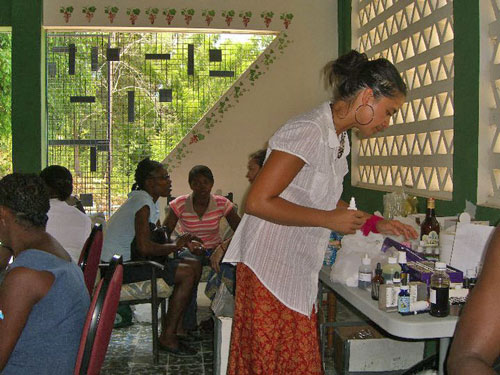
A man who seemed to be about to lose consciousness again
was brought in by his wife, who had found him unconscious on the pavement. Oliama adjusted his foramen ovale with certainty and we sent him home to rest (with some homeopathic Arnica), where he quickly recovered from the concussion.
We were asked to attend to a young woman who had been given up to die.
She had had a bad abscess on her neck grow so that by now it had been open for two months. She was bedridden from the oozing wound, was reduced to a mere skeleton, and the doctors did not know what was wrong with her. She was sure to die some time soon. We gave her some herbal powders to poultice the wound, along with essential oils for antiseptic wound care, homeopathic Silica, and flower essences to help her regain spirits. The abscess started to heal almost immediately and was 30% smaller within a week. Most importantly, the young woman had regained her spirits and started to feel some appetite and interest in food.
One woman in her sixties arrived, looking deranged.
She looked side to side and squinted, holding her abdomen with one hand, head with the other. She was unable to make eye contact. My translator and the man sitting behind her had to yell in order for her to hear my intake questions. She had lost her hearing, had terrible digestive problems, and felt sick all the time. I asked her if this was since the earthquake and she said, “Yes”—the word ‘earthquake’ triggered rapid heaving like she was going to vomit. I shouted for a purge bowl, and grabbed the homeopathic Nux Vomica. I gave her a dose, and rubbed Benediction Oil
on her stomach. She instinctually ripped open her shirt buttons so I could also apply it to her heart center. The heaving and belching got dramatically worse for one minute, then ceased. She sat up straight, looked me right in the eyes, and said “Bless you child. God Bless you.” Her ears unblocked, she could hear again, and she was smiling.
A man in the waiting crowd kept starting to quarrel and fight,
came back each time he had been kicked out, and would not stop and stay quiet, frightening everyone around him with his aggressive behavior. Julia looked up from her client and shouted at Jinpa, “That's tertiary syphilis [slowly developing insanity], test Syphilinum on him!” Jinpa took the man to the side and pulse tested the remedy. The man shouted, “I do not want to get treated, what are you doing, are you going to kill me?” Since the remedy brought his agitated pulse back to normal, Jinpa gave him a dose. This turned the man mellow on the spot, and he broke out in tears, stopped acting “insane” and unprompted, poured out his own story: “During the earthquake, my house collapsed, and two of my children were killed. I also lost my job, and I feel that I am going insane. I cannot feed my children, nor send them to school, so I am drinking instead, because I feel like I am going insane. And I know I am destroying myself by drinking! I swear that I will stop drinking from now on! Thank you very much.”
We had a similar scene the next day in a different location, Jinpa said,
“I was treating a girl who had chest pain.
Her description was pain, but none of the herbs tested correctly on her pulse. This seemed to be a rare case where the pulse testing technique did not seem to be working. So, while I went off to consult the other herbalists, just to give her something to do, I asked her to rub some Benediction Oil onto her heart. When I returned, she looked straight into my eyes and said almost shocked: ‘The pain is entirely gone!’”
One retired gentleman had traveled all the way to the US to seek treatment for his disease.
He came back to tell us that he was shocked to find that he had spent all of the money on the plane ticket in vain, only to find the cure at our backyard clinic.
The practitioners
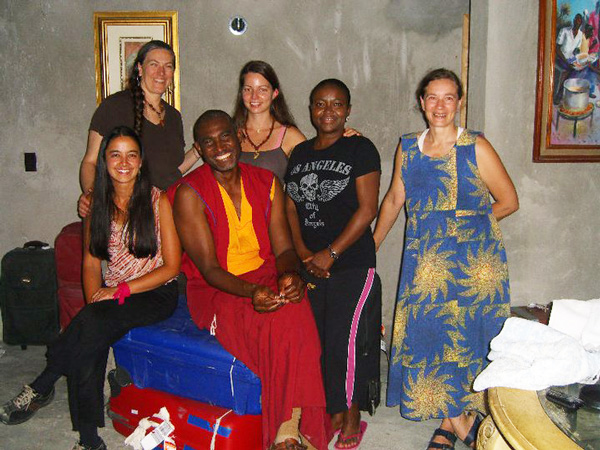
Sandra Lory
Sandra is a Vermont village herbalist and loves to create community gardens.
“For me this trip was an incredible experience of outpouring of love. From the moment of trying to raise all the money and medicines, countless people came forward to help and contribute. It is as if I was just the vehicle coming to bring it all here, and in this way love directly begets love. And then being here was incredible with all those people being so happy and grateful. Being part of this project was a true blessing for me.”
Read
more about Sandra's experience.
Cynthia Thomas
Cynthia is an herbalist, massage therapist and doula in Minneapolis, MN
Marguy Gerton
Marguy is a Florida-based Haitian-American physiotherapist and homeopath.
“I enjoyed the experience of working at the clinic very much. I have never seen such an interweaving of alternative methods before, such as using homeopathy with herbs, flower essences, essential oils and body work. It seemed to me that we were treating body, mind and soul all in one, sending them away with something for everything. I said, ‘We are giving people a complete body make-over here.’ I also really enjoyed when people returned to the clinic and reported how the remedies helped heal them.”
Gabrielle Simon
Gabrielle is an herbalist and body worker in Queens, NY
“My experience working in the clinic has been transformational on many levels. During the initial phases of fundraising, the outpouring of generous donations, both monetary and herbal, was truly heartwarming and overwhelming. It seemed that so many people were deeply moved by the suffering of the Haitian population and sincerely wanted to help. I think I carried that support and compassion with me to Haiti and was able to transfer it to the patients in clinic.
“The desperation of the poor in Haiti is unimaginable for most Americans. Many patients were suffering tremendously, and yet they waited in line for hours and were extremely grateful for the care they received. The resilience, strength and self-sufficiency of the children was amazing. I was so honored to have the opportunity to help the children because they carry a heavy emotional burden from the earthquake. It seemed that most lost between 5 and 10 family members in the disaster and yet they described themselves as "the lucky ones" just to be alive. Even those who didn't see death during the earthquake itself were exposed to dead bodies and the smell of decay for many weeks after and were deeply impacted emotionally.
“Treating the acute symptoms of flu epidemic, chronic malaria, staph infections and worms, was of course important, but being able to offer the people treatment for post-traumatic stress through the flower essences and homeopathic remedies was transformational. It doesn't seem as if any other organizations are offering this support and it was clear that so many of the physical ailments, from migraines to heart palpitations, were due to emotional trauma. I remember taking the pulses of a few children who were trembling all over and said they had been since the earthquake. After just placing the correct flower essence in their hand, the trembling stopped altogether. We all saw these profound effects and cures with the herbs on a daily basis in the clinic.
“We were able to provide so much relief to the patients, but on many occasions it was clear that herbs and supplements would not be enough to cure those still suffering from extreme malnutrition and lack of clean water. A month after the clinic I find myself thinking daily of the impoverished children whose basic needs are not being met and hoping they are able to maintain their strength, hope and grace. My deepest wish is that these fundamental problems are addressed as Haiti continues to recuperate.”
Thupten Jinpa
Jinpa is a Haitian-American herbalist, homeopath and body worker.
“It was a wonderful experience. Healing one child is like healing one or two generations into the future in Haiti. So I am very happy that this time I was able to treat so many children. And I still enjoy how the medicines change the children's mood in one instance from grouchy and closed down to happy and open. They may be fuzzy and even refuse to let me touch them to take the pulse, but once I find the right remedy, they let me touch them, hold on to the remedy and do not want to let it go. I still love that part, and to see how that shift lasts, because it is still there in all the returning children clients after seven months of my absence.”
Julia Graves
“I came back to Haiti remembering those destitute children. Whenever I spend the day treating a huge number of miserably sick people, I feel that my life has been worth living. There is nothing more rewarding than saving the life of a baby.”
Oliama
and his sister
Eliane
, both herbalists, bonesetters and midwives in the Afro-Haitian tradition, who live in the locale in which the clinic was held.
|

![]() and then Add to Home Screen.
and then Add to Home Screen.









